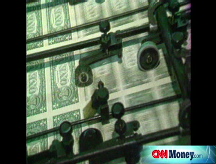Business lending still pinched
A critical source of short-term funding for major businesses and banks falls again.
NEW YORK (CNNMoney.com) -- One important method of short-term lending remained under fire last week, but there were signs of hope for it.
Total outstanding commercial paper, a key form of lending to major businesses and banks, fell by $40.3 billion, or 2.6%, in the past week, to $1.5 trillion, according to the latest figures from the Federal Reserve released Thursday.
The slide is slightly less than the $56.4 billion, or 3.5%, drop the week before.
However, the market for commercial paper is still contracting. A year ago, there was $1.9 trillion outstanding. And it has declined for five straight weeks, dating back to the bankruptcy of Lehman Brothers on Sept. 15. Since then, many leading buyers of commercial paper have looked beyond the market that most considered very safe just a month ago.
"It's important that the decline is decelerating, but lots of confidence still needs to be rebuilt in the market," said Steve Van Order, chief fixed income strategist at Calvert Funds. "Generally speaking, the signs are improving, but very slowly."
Commercial paper is short-term debt that big businesses and financial institutions sell primarily to money market fund managers and other institutional investors. The companies use the loans to fund day-to-day business operations.
With major investors nervous that they'd end up with the debt of a stable company that could suddenly go under - like Lehman - many shifted to even safer investments like U.S. Treasurys instead.
A month of fear has sent total commercial paper outstanding down $305.2 billion, or 16.8%, as confidence sank on Wall Street.
As a result, the Fed two weeks ago announced an unprecedented program in which the central bank would buy up large amounts of paper.
The Fed said Tuesday that the plan would be implemented on Oct. 27, nearly three weeks after the program was first announced.
Fed officials said last week they hoped that just the announcement of the Fed's plans to buy commercial paper would calm investors.
"Like other programs that have been announced recently, we're not going to get an immediate pop," Van Order said. "We have to wait for the programs to be put in place, and then people have to find out if it's going to work out for them."
The plan entails the purchase of high-quality three-month commercial paper from issuers who have found themselves with limited access to the commercial paper market. But it will be up to the companies to join.
"The program is trying to take care of companies who are being shut out of the market," Van Order said. "But not every corporation is shut out - some can get good rates naturally through the market."
Another sign that panic in the market is calming down is that interest rates on commercial paper loans have finally dropped near pre-Lehman levels. Some non-financial paper rates have even fallen lower than levels seen right before Lehman's collapse.
Lower interest rates make it easier for companies to lend to one another. Still, it will take some time for the credit crisis to come to an end.
"Banks borrowing commercial paper have reported that it's getting easier to get into the market, but we're not out of the woods yet," Van Order said. "These are signs of improvement, but not signs of normality." ![]()





